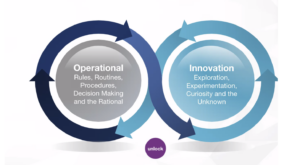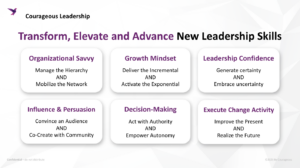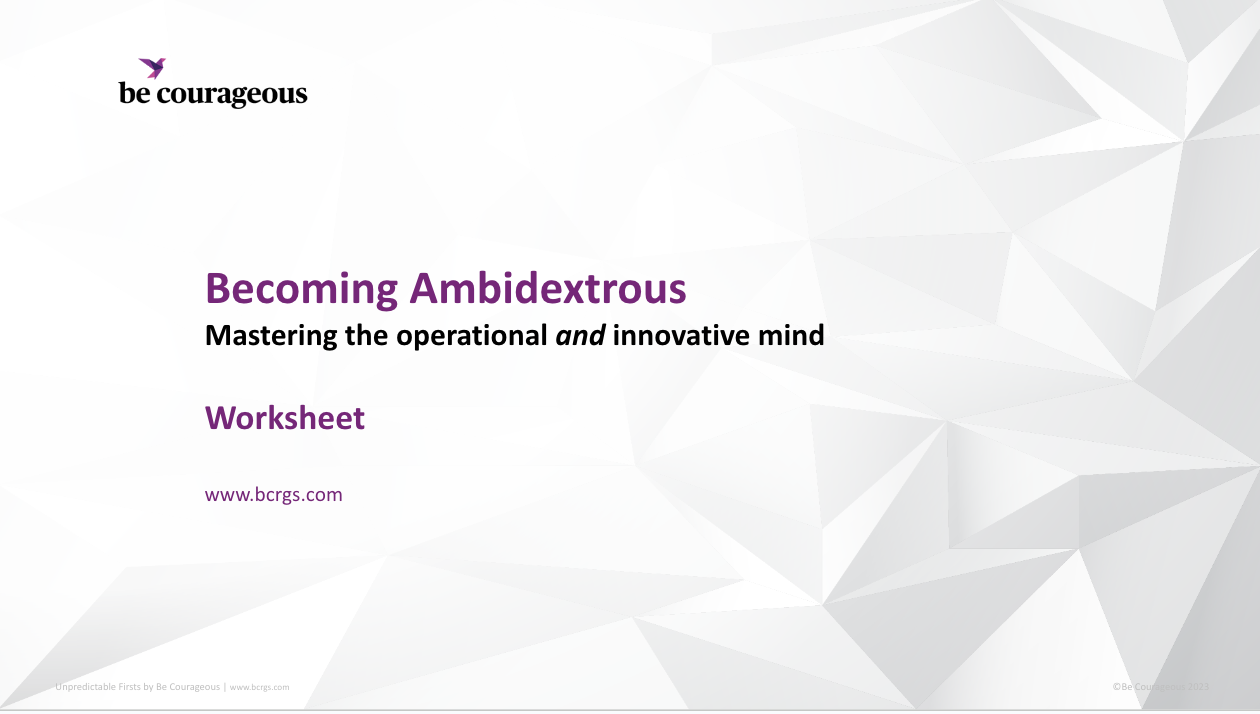Tomorrow's leaders have to be versed in both innovation and operational mindsets -- ambidextrous leadership.
Remember when leaders were either focused on innovation OR operations?
Like typewriters and paying less than five dollars for coffee, gone are the days of, “I work in innovation, so I don’t need to focus on operations,” or “I’m focused on operations and don’t need to spend time on research and development of new ideas.”
Operational and innovation mindsets may seem like they go together like oil and water, but cycling between these two mindsets has become crucial to being a successful, future-ready, antifragile, and courageous leader. Enter: Ambidextrous Leadership.
“Operational-centric” companies started with innovation
Legacy companies with a history spanning 100 years aren’t considered the most trailblazing anymore, but they’re rooted in innovation. Companies like General Electric or Ford were founded on groundbreaking ideas that solved unmet needs, significantly improving consumers’ lives and changing how we live and work.
As these companies grew to hundreds of thousands of employees with vast product lines, they had to transition into operational rigor, establishing processes and systems to ensure consistent, scalable, and repeatable success.
And it works. Companies like Heinz, known for perhaps not the sexiest but highly successful products, such as canned beans and ketchup, owe their enduring success to their ability to operationalize their systems effectively.
But legacy companies cannot be complacent. New disruptors will emerge, ready to challenge the status quo and shift how consumers live daily.
Legacy companies, once the disrupters themselves, now struggle with getting out of their comfort zones when they’re not used to having to do anything differently to succeed. We’ve been coaching many of these companies to help them navigate unprecedented changes and the unknown, transform their culture, and re-ignite the innovative spirit that drove their initial success.
“Innovation-centric” companies need operational expertise
Small, young, innovative companies are still discovering who they are, what they do, and how to scale, all while facing huge goals of creating, building, testing, learning, and iterating.
These companies haven’t yet defined the right systems and operations for scale. They’re still in an agile, iterative, fast-moving, creative mode, needing to acquire customers and respond to testing.
But innovative-centric companies can no longer be ambiguous in leadership. Experts in an innovative environment are being asked to be more structured, deliver at scale, streamline workstreams, build a more operational-minded workforce, stay on budget, and provide consistent returns for investors and shareholders, just like a legacy company.
Switching between two worlds
Innovation and operations are two different worlds. And it’s impossible for our brains to be in both of these worlds at the same time. But we can cycle between them quickly, with intentional practice. Each of these worlds and their characteristics and traits play a pivotal role in the right moments of the business-building and scaling process.
Operational World | Innovative World |
Systems | Fluidity |
“If it ain’t broke, don’t fix it.” | Break stuff |
Limiting | Freedom |
Predictability | Curiosity |
Known | Experimenting |
Rational | Irrational |
Procedures & Rituals | Loose or no guidelines |
Efficiencies | Anything goes |
No surprises | Finding fall edge |
Doing things the way we’ve always done | Creativity |
Safe | Risk-taking |
What are some of the different traits you are experiencing? | |
There’s no right or wrong with these traits; they all play essential roles in the right circumstances.
In this dynamic landscape, the ability to switch between innovation and operation mindsets is crucial and requires courageous leadership.
Mastering ambidextrous leadership
An ambidextrous leader possesses understanding (even if one is primary and the other secondary) in both realms and can cycle between them based on the situation or conditions.

Image adapted from original source: Synectics ITW training
As Bruce Lee says, “Be like water.”
Being ambidextrous is a skill that allows leaders to speak the language of innovation and operation fluently, enabling them to adapt to various situations and effectively balance the demands of the business.
Knowing, “When is it the right time to operate? When is it the right time to innovate?” is mastering ambidexterity.
Leading takes all the skills
When we’re called into companies (in all industries from food brands to energy) to do leadership training, and we ask what core competencies they want their teams to develop and master, they’ve recently been listing up to 30 to 40 traits.
When we ask them to choose a handful of the most critical skills to focus on, the answer has recently been, “All of them. We can’t cut any of these. We need our leaders to know how to do them all.”
This signals to us that companies don’t know which skills to hone in on because the future is no longer as predictable as it used to be. They want their leaders to be great at everything, just in case!
Today’s leaders need to handle insane growth and the unknown by learning and knowing when to apply a wide range of competencies.
Ambidextrous leadership has become not just desirable but crucial.
It’s an “And,” not “Or”

Here’s an easy way to visualize what it means to be agile and pragmatic simultaneously, generating predictable returns while also remaining fearless in the face of an unpredictable future.
Ambidexterity: The future-ready leader’s super-skill
Approaching life as an “either/or” proposition may suit A/B testing, predictable moments, or benchmarking against past situations. But there’s nothing predictable about this rapidly evolving business landscape. Except for “The only thing certain is change.”
Therefore, embracing the concept of “and” is vital. Be bold and cautious, and adapt to new realities without only relying on old binary models.
Innovation and operational excellence are complementary forces that, when harnessed together, can lead to extraordinary results.
Today’s leaders must be adaptable and fearless in the face of uncertainty while balancing the demands of established processes and systems.
Ambidextrous leadership — developing practical and imaginative skills — is the path to enduring success.
Know the language and skills of the area you’re not immersed in daily, and work to improve it, so you can more easily move in between the worlds and different modes of thinking, leading with the right skills based on the circumstances in front of you.
Free Ambidextrous Leadership Tool
Practice shifting from operational to innovation mindsets to be future-ready leader.
If you or your team would be helped by a workshop, coaching, or consulting on ambidexterity in leadership, reach out, we can help!
Co-Writer: Shannon Geher


